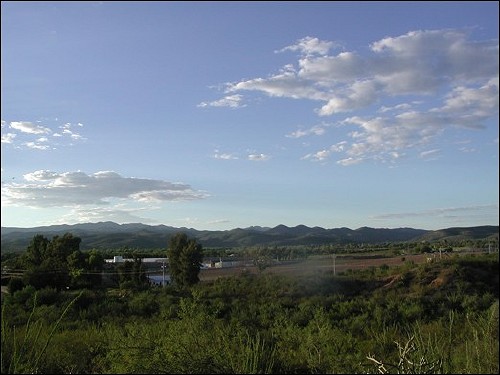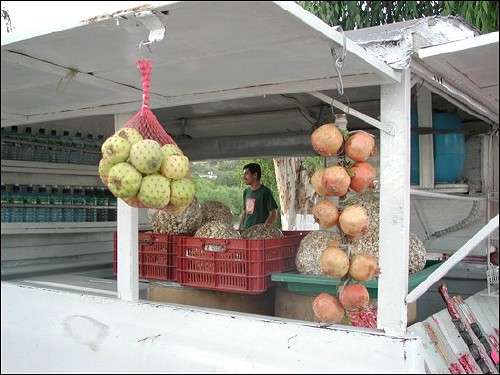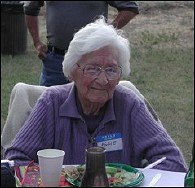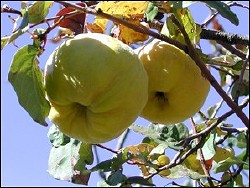The Kino Heritage Fruit Trees Project
Jesús Manuel García-Yánez, Arizona-Sonora Desert Museum & Robert M. Emanuel, University of Arizona
Las Matas: Project Origins & Methods
In 2004, Tumacácori National Historical Park, an important mission site in southeastern Arizona, completed the acquisition of an original 5-acre mission orchard and a significant portion of its original agricultural area. In 17th and 18th centuries missionaries, including Jesuit Padre Eusebio Francisco Kino introduced European fruit trees to this region, catalyzing an agricultural transformation. The goal of the Kino Fruit Trees Project is to assist the National Park Service in replanting appropriate varieties of those fruit trees on this land. This has involved the project's team in an ethnohistorical, ethnobotanical and horticultural adventure. This poster introduces the project, initial results, and new directions.
The Kino Heritage Fruit Trees Project is a multi-partner, community-sponsored program designed to reintroduce appropriate fruit trees to Tumacácori National Historical Park as well as surrounding heritage parks in the Santa Cruz Valley and Missionized region of Southern Arizona.
The primary goal of the Kino Fruit Trees Project is to assist the National Park Service in replanting historically, culturally and horticulturally appropriate varieties of those fruit trees on this land. Secondary goals include:
- Develop appropriate interpretative materials for the Park Service to use once the orchard has been re-established.
- Research local and regional linkages that bring the living history of the orchard into context with historic and contemporary Hispanic, Native American, and European American cultures in the region.
- Develop methods for propagating and cultivating these cultivars in part based on existing local knowledge and modern horticultural techniques.
- Distribute trees, knowledge, and other project benefits to entities and communities throughout the region in an equitable way.
Methods
The methodology for the project was originally designed to support tasks around gathering information on the trees, their locations and history. Throughout the course of the project, we have found it necessary to adapt to new information and take advantage of new opportunities. In some cases, we found it advantageous to collect trees ahead of schedule as they became available for propagation or with fleeting opportunities to visit these locations and families cultivating them.
- Archival Research in U.S. & Mexico
- Mission site visits throughout the study area
- Collection of plant propagules - cuttings, graftings, seeds
- Collection of personal oral and tree histories
- Collection of global positioning system (GPS) data points
- Photographic documentation
- Herbarium specimen collection
- Increasing public participation


The Kino Fruit Trees Project focused on identifying communities where continuous or semi-continuous occupation meant that fruit trees might have persisted since the missionization period.


Communities Founded By Padre Kino
| Spanish Town | Date | Contemporary Town |
|---|---|---|
| Nuestra Señora de los Dolores | 1687 | Cucurpe |
| Nuestra Señora de los Remedios | 1687 | El pintor |
| San Ignacio de Caburica | 1687 | San Ignacio |
| San Pedro y San Pablo del Tubutama | 1687 | Tubutama |
| Santa Theresa de Atil | 1687 | Átil |
| Santa Maria Magdalena | 1687 | Magdalena |
| San Jose de Imuris | 1687 | Imuris |
| Nuestra Señora del Pilar y Santiago de Cocóspera | 1689 | Cocospera |
| San Antonio Paduano del Oquitoa | 1689 | Oquitoa |
| San Diego del Pitiquito | 1689 | Pitiquito |
| San Cayetano de Tumacácori | 1691 | Tumacácori |
| Los Santos Angeles de Guevavi | 1691 | Rio Rico |
| San Lázaro | 1691 | San Lázaro |
| San Xavier del Bac | 1692 | San Xavier District |
| San Cosme y Damian de Tucson | 1692 | Tucson/San Xavier |
| La Purísima Concepción de Nuestra Señora de Caborca | 1693 | Caborca |
| Santa Maria Suamca | 1693 | Santa Cruz |
| Nuestra Señora de Loreto y San Marcelo de Sonoyta | 1693 | Sonoyta/Quitobaquito |
| Nuestra Señora de la Ascencion de Opodepe | 1704 | Opodepe |
| Los Santos Reyes de Sonoita | 1692 | Sonoita/Patagonia |










